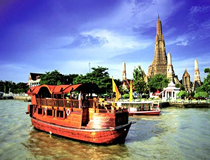BANGKOK CITY

Bangkok is the capital and largest populated area of Thailand. In Thai, it is called as Krung Thep or the "City of the Deity". It was began as a small port community and trading center near the Chao Phraya River before the peak of the Ayutthaya Kingdom, a precursor of modern Thailand (1350 - 1767). After the Ayutthaya fell, the new King Taksin set up a new capital in an area of then Bangkok, which was known as Thonburi. When his reign ended in 1782, the next king, Yodfa Chulaloke rebuilt the capital and gave it an official name, Krung Thep Maha Nakhon.
It also inherited the name Bangkok and continued to be used by the world community and also became its formal English name, while for Thais, the name Bangkok only refers to an old district located on the west bank of the Chao Phraya.
CITY ATTTRACTIONS :
The city has since undergone numerous changes and vastly modernized, including the introduction of utility infrastructure and transportation in the reigns of King Chulalongkorn, and King Mongkut, it quickly developed into the largest economic center of Thailand.
The foremost tourist attraction in Bangkok is the Grand Palace which was built in 1782 and housed the royal family for 150 years. The complex was an important part in Thai monarchy: it includes royal courts and administrative branches. It has a grand golden temple, intricate carvings and Buddha statues, your visit will be accompanied by permeating incense and the chanting of monks abound. Vests and shorts are not allowed and skimpily dressed tourists are required to borrow brightly colored loose-fitting clothes for free. Don't end your visit at the emerald Buddha; the gardens and throne rooms further back are absolutely worth seeing too. Unless you're fascinated by Buddhist art the entire complex can be visited in a couple of hours.
Wat Pho is among the oldest and largest wats in Bangkok (80,000 m2), and more than 1000 Buddha images, and also has one of the biggest single Buddha statue: the Reclining Buddha. It is 46 meters long and 15 meters high, its body is decorated with gold plating and nacre on its eyes and the soles of its feet. The soles display more than 100 auspicious scenes in Indian and Chinese styles
Wat Arun is one of the most photographed landmarks in Bangkok (particularly during sunset), and understandably so. The temple is simply beautiful from a far. If you've finished your visit in Wat Pho, you can reach Wat Arun by using the Chao Phraya "cross river" ferry. The Wat Arun compound is simply stunning design and majestic. You can climb up using a narrow and steep stairs. Even so, your effort climbing up will not be left unrewarded. The scenery from the top of the temple is impressive and gives you a clear panoramic view on the old Bangkok and the Chao Phraya river.
Wat Suthat was constructed in the early nineteenth century to house a large 25 feet tall statue of Phra Sri Sakyamuni (Buddha), it features a red frame of a large swing once used in yearly ceremonies to celebrate Shiva.
Chatuchak is the biggest market in Thailand. Commonly called J.J., it covers more than 1.13 km² (35 acres) and contains more than five thousand stalls. Most stalls only open on weekends. It is suggested to wear something as light and comfortable as possible in terms of footwear and clothing. It will be blistering hot when the sun is high and bring a bottle of water to avoid dehydration. In general, one day won't be enough to cover the entire market and most likely you'll return to this market over and over again because the bargains are simply too good to resist.
